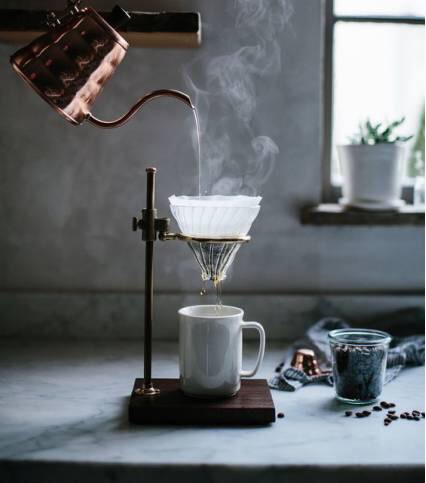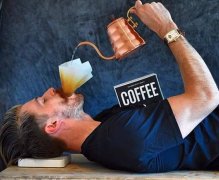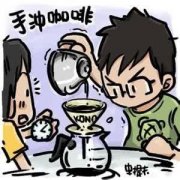Common mistakes of hand-brewing coffee how to master the direction and speed of water injection?

Professional coffee knowledge exchange more coffee bean information please follow the coffee workshop (Wechat official account cafe_style)
Seven factors affecting hand-brewed coffee
Common mistakes in making coffee by hand
Coffee beans
Error 1: degree of grinding
A good bean grinder can ensure that the coffee powder is evenly ground. If the coffee powder is uneven and the fine powder is too much, it will make the coffee taste not "pure".
What is the suitable thickness of hand-brewed coffee beans?
The answer is: moderate grinding, the size of granulated sugar. If the coffee powder is too thick and the hot water flows too fast, it is difficult to extract the aromatic substances from the coffee. If the coffee powder is too fine, the filter is easy to clog, resulting in water and powder soaking time is too long, coffee will appear bitter, astringent taste.
Error 2: freshness
Many people choose ground coffee powder for convenience, or grind a lot at one time and put it in the refrigerator. In fact, "fresh grinding" is the first condition of good coffee, it ensures the taste of coffee.
When the coffee is ground into powder, the oxidation rate of the coffee powder is accelerated, and the aroma begins to lose in 40 seconds. If the aroma of coffee powder is seriously lost, the flavor of natural coffee will disappear.
Error 3: cloth powder
After pouring the coffee powder into the drip filter cup, gently shake it to make it flat, this is a very easy to ignore step, or too hard, shake too many times, it is not advisable. The smoothness of the flour determines the uniformity of stewing and extraction of hand-made coffee, which directly leads to the taste of the coffee.
two
water
Error 1: water quality
If you care about taste, don't ignore the water used to make coffee. 98% of a cup of hand-brewed coffee is water, and the range of soluble matter (TDS) in water is preferably between 100 and 250ppm. It is not recommended to use pure water to make coffee. Coffee made with pure water often tastes dull and lacks a sense of hierarchy. But do not use mixed brand mineral water or mixed brand barreled water, once there is a strange smell in the water, it will be more obviously magnified and reflected in the coffee.
Error 2: water temperature
Water temperature is also an important indicator that affects the taste of coffee. Too high water temperature will make coffee bitter, while low water temperature will make coffee sour. Suggestion: deep roasted coffee beans are suitable for 80-85 degrees, while medium and shallow roasted coffee beans are suitable for extraction at about 90 degrees.
Error 3: current
Whether the aroma and hierarchy of coffee can be released heartily, the key lies in water injection. Common mistakes are:
a. The injected water column is too large and the direction of the water column is too tilted, which will cause the water to flush a hole in the side of the powder layer and run away directly from the filter paper, resulting in insufficient coffee extraction.
b. The water column is pulled too high, resulting in the flow of water to destroy the coffee powder, easy to inject bubbles, and uneven coffee extraction. It will also lead to too much water column and contact air area, and the water temperature will be affected, so the water column must be as close to the coffee as possible.
c. The water flow is unstable, sometimes large and small, sometimes dashing, sometimes ticking off, resulting in different degrees of soaking in different areas of coffee powder, and the taste of coffee will be affected.
Error 4: water quantity
As different people have different tastes, different requirements for shade are different. The range of extraction concentration is 1.15% Mel 1.35%, and the proportion of water used is about 1:13 to 15. Some people use very little water simply in pursuit of richness, but it doesn't taste good. On the contrary, some people expect to extract more substances with more water, but they do not realize that the later the extraction is, the lighter it is, and the final concentration is not enough.
Have you found your own problem in these places? If you want to make a good cup of coffee, all aspects of control must be very exquisite! Diligent practice is also essential.
three
How to handle the size of water injection when making coffee by hand?
When brewing hand coffee, it will first go through the steaming stage, the time is about 15 60cc 30 seconds, let the coffee powder absorb water, the coffee powder that absorbs enough water will expand, and produce another kind of aroma, the longer the steaming time, the stronger the coffee flavor, usually the amount of steaming water is twice that of coffee powder, for example, 30 grams of coffee powder, about pour the water of coffee powder to make the coffee powder absorb enough water.
After stuffy steaming, the action of water injection is carried out. it is generally recommended that beginners use a fine-mouthed hand flushing pot, which is not easy to fail; at the beginning of water injection, it is easy to extract coffee, if you are an ordinary hand flushing pot, do not use too much water at the beginning, and use a large water injection near the end to avoid flushing out too many impurities. The ideal time for the whole water injection is about one and a half to two and a half minutes. If you want the coffee to taste thicker, you can slow down, "taste it, but don't overdo it."
four
How to master the direction and speed of water injection?
The direction of water injection can start from the center, around the outside of the circle to the clockwise direction, to remember that the biggest impact is not to rush to the filter paper.
In addition, another technique when brewing coffee is to cut off the water, which is to interrupt the water injection process. This action can make the hand-brewed coffee taste not too heavy or too thin. For example, the water in 360cc can be interrupted at half the 180cc, and then continue to pour water until the water level on the coffee powder drops. This can adjust the flavor of the hand-brewed coffee and make it stronger. In addition, when the water column is too large, you have to cut off the water to avoid causing the taste to be too light, so you can change the taste of hand-brewed coffee and adjust the extraction rhythm by cutting off the water. It is recommended one or two times.
What sounds easy and natural, there are thousands of ways to do it. The gesture of pouring water and making a circle can be divided into counterclockwise, large and small circles, making a cross, drawing an M, and so on. In fact, whether it is a picture symbol or a "gluttonous snake", you can inject water into a coffee pressed powder in the hope of washing out the taste of each powder. Metaphorically, the coffee powder in the funnel is like a tea bag in a bathtub. We pour water with a hose in the hope that each tea bag will taste evenly together. To do this, you must first wet all the tea bags at the same time. This is the goal of the first water injection (or "stuffy steam" at all).
However, if you look at the funnel with a microscope, you will find that the size of the coffee powder is different. It is equivalent to the tea bag in the bathtub, some as big as rice dumplings and some as thin as dumplings. Even if the extraction starts at the same starting line, by the time the big one tastes enough, the thin one has gone too far (excessive extraction). In order to avoid this phenomenon, apart from high-quality bean grinders, we can only use water to pull larger coffee grains to taste as soon as possible before the fine powder is over-extracted.
So when the second water injection begins, the impact is very important.
Important Notice :
前街咖啡 FrontStreet Coffee has moved to new addredd:
FrontStreet Coffee Address: 315,Donghua East Road,GuangZhou
Tel:020 38364473
- Prev

Why can't you make a good cup of hand-made coffee?
Professional coffee knowledge exchange more coffee bean information Please follow the coffee workshop (Wechat official account cafe_style) Seven factors affecting hand-brewed coffee many friends said, why can't you make a good cup of hand-brewed coffee even though you have followed the steps? Now the editor exposes the common mistakes of making coffee from three angles! A good cup of hand-made coffee can be tasted
- Next

Hand-made coffee tutorial: don't laugh! Common mistakes that people who are handy also encounter.
Professional coffee knowledge exchange more coffee bean information Please pay attention to the seven factors affecting hand-brewed coffee in the coffee workshop (Wechat official account cafe_style) although it is said that hand-brewed coffee is much simpler than the siphon pot, it is because of simplicity, the subtle delicious key is easy to be overlooked, many people after several years, only to find that they have made a lot of mistakes in hand-brewing coffee
Related
- Beginners will see the "Coffee pull flower" guide!
- What is the difference between ice blog purified milk and ordinary milk coffee?
- Why is the Philippines the largest producer of crops in Liberia?
- For coffee extraction, should the fine powder be retained?
- How does extracted espresso fill pressed powder? How much strength does it take to press the powder?
- How to make jasmine cold extract coffee? Is the jasmine + latte good?
- Will this little toy really make the coffee taste better? How does Lily Drip affect coffee extraction?
- Will the action of slapping the filter cup also affect coffee extraction?
- What's the difference between powder-to-water ratio and powder-to-liquid ratio?
- What is the Ethiopian local species? What does it have to do with Heirloom native species?

